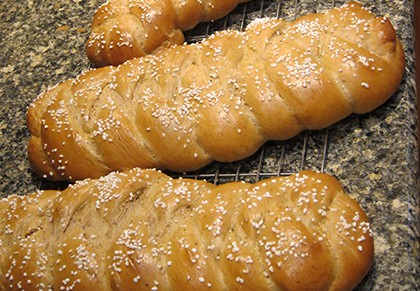2-lb boned filet from a salmon weighing 10-15 lbs. 2 T. coarse sea salt 2 tsp. granulated sugar 2 tsp. coarsely crushed white peppercorns ó cup of chopped baby dill lemon wedges Combine salt, sugar, pepper, and dill. Place salmon filet skin-side down in stainless steel or porcelain dish. Spread mixture over filet. Cover with plastic wrap…
by Debbie Halinen Santelli 1 pint buttermilk 1/2 cup sugar 1/2 cup shortening, melted 1 teaspoon salt 7/8 teaspoon baking soda Coarse rye flour Mix ingredients to make a thick dough and shape into 24 balls, dipping them in flour. Roll out very thin with a special peg rolling pin (a barbed pin which pricks dough as it…
by Syrene Forsman 1 package active dry yeast ½ cup warm water 2 cups milk, scalded and cooled to luke warm (I heat the sugar, salt and cardamom in the milk as well) 1 cup sugar 1 tsp salt 2 tbs ground cardamom pods (grind with a clean coffee grinder) 4 eggs, beaten 8–9 cups sifted white…
